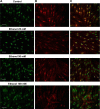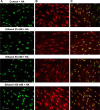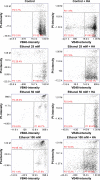Protective influence of hyaluronic acid on focal adhesion kinase activity in human skin fibroblasts exposed to ethanol
- PMID: 28293103
- PMCID: PMC5345991
- DOI: 10.2147/DDDT.S125843
Protective influence of hyaluronic acid on focal adhesion kinase activity in human skin fibroblasts exposed to ethanol
Abstract
Aim: The aim of this study was to evaluate the effect of ethanol and hyaluronic acid (HA) on cell survival and apoptosis in cultured human skin fibroblasts. Regarding the mechanism of ethanol action on human skin fibroblasts, we investigated cell viability and apoptosis, expression of focal adhesion kinase (FAK), and the influence of HA on those processes.
Materials and methods: Studies were conducted in confluent human skin fibroblast cultures that were treated with 25 mM, 50 mM, and 100 mM ethanol or with ethanol and 500 µg/mL HA. Cell viability was examined using methyl thiazolyl tetrazolium (MTT) assay and NC-300 Nucleo-Counter. Imaging of the cells using a fluorescence microscope Pathway 855 was performed to measure FAK expression.
Results: Depending on the dosage, ethanol decreased cell viability and activated the process of apoptosis in human skin fibroblasts. HA prevented the negative influence of ethanol on cell viability and prevented apoptosis. The analysis of fluorescence imaging using BD Pathway 855 High-Content Bioimager showed the inhibition of FAK migration to the cell nucleus, depending on the increasing concentration of ethanol.
Conclusion: This study proves that downregulation of signaling pathway of FAK is involved in ethanol-induced apoptosis in human skin fibroblasts. The work also indicates a protective influence of HA on FAK activity in human skin fibroblasts exposed to ethanol.
Keywords: apoptosis; ethanol; focal adhesion kinase; hyaluronic acid; skin fibroblast.
Conflict of interest statement
Disclosure The authors report no conflicts of interest in this work.
Figures




Similar articles
-
Hyaluronic acid abrogates ethanol-dependent inhibition of collagen biosynthesis in cultured human fibroblasts.Drug Des Devel Ther. 2015 Nov 24;9:6225-33. doi: 10.2147/DDDT.S91968. eCollection 2015. Drug Des Devel Ther. 2015. PMID: 26648698 Free PMC article.
-
Influence of caffeine and hyaluronic acid on collagen biosynthesis in human skin fibroblasts.Drug Des Devel Ther. 2014 Oct 15;8:1923-8. doi: 10.2147/DDDT.S69791. eCollection 2014. Drug Des Devel Ther. 2014. PMID: 25342885 Free PMC article.
-
Hyaluronic acid signals for repair in ethanol-induced apoptosis in skin cells in vitro.Clin Biochem. 2010 Jul;43(10-11):822-6. doi: 10.1016/j.clinbiochem.2010.04.005. Epub 2010 Apr 14. Clin Biochem. 2010. PMID: 20398644
-
Mediation of the migration of endothelial cells and fibroblasts on polyurethane nanocomposites by the activation of integrin-focal adhesion kinase signaling.J Biomed Mater Res A. 2012 Jan;100(1):26-37. doi: 10.1002/jbm.a.33224. Epub 2011 Oct 4. J Biomed Mater Res A. 2012. PMID: 21972215
-
The effect of hyaluronic acid on interleukin-1-induced deregulation of collagen metabolism in cultured human skin fibroblasts.Pharmacol Res. 2005 May;51(5):473-7. doi: 10.1016/j.phrs.2004.12.002. Pharmacol Res. 2005. PMID: 15749462
Cited by
-
8,9-Dihydrocannabidiol, an Alternative of Cannabidiol, Its Preparation, Antibacterial and Antioxidant Ability.Molecules. 2023 Jan 3;28(1):445. doi: 10.3390/molecules28010445. Molecules. 2023. PMID: 36615636 Free PMC article.
-
Hyaluronic acid and epidermal growth factor improved the bovine embryo quality by regulating the DNA methylation and expression patterns of the focal adhesion pathway.PLoS One. 2019 Oct 29;14(10):e0223753. doi: 10.1371/journal.pone.0223753. eCollection 2019. PLoS One. 2019. PMID: 31661494 Free PMC article.
-
Hyaluronan Hydrogels for Injection in Superficial Dermal Layers: An In Vitro Characterization to Compare Performance and Unravel the Scientific Basis of Their Indication.Int J Mol Sci. 2021 Jun 2;22(11):6005. doi: 10.3390/ijms22116005. Int J Mol Sci. 2021. PMID: 34199374 Free PMC article.
References
-
- Seth D, D’Souza El-Guindy NB, Apte M, et al. Alcohol, signaling, and ECM turnover. Alcohol Clin Exp Res. 2010;34(1):4–18. - PubMed
-
- Neuman MG, Haber JA, Malkiewicz IM, Cameron RG, Katz GG, Shear NH. Ethanol signals for apoptosis in cultured skin cells. Alcohol. 2002;26(3):179–190. - PubMed
-
- Neuman MG, Nanau RM, Oruña L, Coto G. In vitro anti-inflammatory effects of hyaluronic acid in ethanol-induced damage in skin cells. J Pharm Pharm Sci. 2011;14(3):425–437. - PubMed
-
- Mello T, Ceni E, Surrenti C, Galli A. Alcohol induced hepatic fibrosis: role of acetaldehyde. Mol Aspects Med. 2008;29:17–21. - PubMed
MeSH terms
Substances
LinkOut - more resources
Full Text Sources
Other Literature Sources
Miscellaneous

